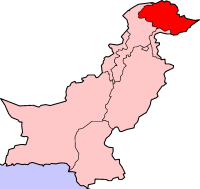Northern Areas, Pakistan
|
|
Kashmir_map.jpg
The Northern Areas, or Gilgit-Baltistan, is the northernmost region of Pakistan, with a population of approximately 1.1 million. The entire area including Gilgit and Baltistan was known as the Gilgit Agency till October, 1947. This is a strategically very important region of the world, which is sandwiched between the high peaks of Hindukush and Karakorum on the north and those of western Himalaya on the south. It borders to the north with Afghanistan and China, to the south with India and Azad Kashmir and to the west with North-West Frontier, Pakistan.
Unlike the area that Pakistan calls "Azad Kashmir," the Northern Areas are incorporated into Pakistan. A small part of Northern Areas was ceded to China by Pakistan in 1963 with the proviso that the settlement was subject to the final solution of the Kashmir dispute. India does not recognize the Northern Areas as belonging to Pakistan and calls the region encompassing Azad Kashmir and the Northern Areas "Pakistan Occupied Kashmir (POK)".
The region was under local rulers for many centuries. The rulers of Hunza were called Mirs, and those of Gilgit were called Raas. Some parts of the region were invaded by Maharajas of Kashmir and they forcefully governed the area for many years, which led to the common belief that it is a part of Kashmir. But the people of Gilgit-Baltistan regard themselves as being distinct from Kashmiris and many want to become the fifth province of Pakistan. And they oppose being included in Kashmir. Their opinion is that invasion of Mahrajas doesn't mean that this is a part of Kashmir, just like British invasion over the India in 19th century does not mean that India is a part of Britain. The region's lack of representation in the parliament of Pakistan has placed it outside the mainstream politics of the country, which has become a major cause of frustration to the inhabitants of Gilgit-Baltistan.
The Northern Areas comprise the two districts of Baltistan and the three districts of Gilgit (where the capital is located). Hunza, an independent principality for 950 years which only came under Pakistani rule in 1974, is also located in this region. The Northern Areas collectively comprise a territory of 27,991 mi² (72,496 km²).
Brushaski, an isolated language, is spoken in Hunza, Nagir, Yasin, some parts of Gilgit, and some villages of Punyal. Although Brushaski is most popular and polite language in the Area, it still is not used by a large portion of population. Shina language with different accents or in different dialacts is the Language of over 40% of total population, spoken mainly in Gilgit, throughout Diamer, and most of the areas of Ghizr. Balti with a similar accent, is spoken by the entire population of Baltistan except some villages. There are also some other languages spoken in the area -- Wakhi is spoken in upper Hunza and some villages in Ghizr, and Khwar is spoken by some Khwar families in Ghizr. None of these languages are related to each other. Urdu is the Lingua franca of the Area. Urdu is understood by almost all men, and literate women.
According to Habib R. Sulemani, "Gilgit-Baltistan" is geographically and politically more suitable than any other term, as it clearly indicates the districts of Gilgit, Ghizer, Diyamer, Skardu and Ganchay, while the term "Northern Areas" confuses parts of the NWFP with Gilgit-Baltistan.
See also
- Terrorism in Kashmir
- Lalak Jan
- NLI
- Kargil War
- Karakoram
- Karakoram Highway
- Indus River
- Nazir Sabir
- Nasir al-Din Nasir Hunzai
- Dr. Faquir Muhammad Hunzai
- Mir Muhammad Jamal Khan
- F M Khan
- Abdul Hamid Khan
- Mir of Hunza
- Farman Ali
External links
- The Changing Northern Areas (http://www.dawn.com/events/lifestyle2002/ls16.htm)
- In search of identity (http://dawn.com/report/islamabad/northern1.htm)
- And when the tourists come (http://www.dawn.com/report/islamabad/northern5.htm)
- Pakistan's Northern Areas dilemma (http://news.bbc.co.uk/1/hi/world/south_asia/1491179.stm)
- Northern Areas Development Gateway (http://www.northernareas.org.pk)
- Pakistan's Northern Areas (http://paknews.com/articles.php?id=1&date1=2003-04-17)
- Northern Pakistan's Karakoram & Hindukush Mountains (http://www.monitor.net/~jmko/karakoram/about-kh.htm)
- The Mountain Areas Conservancy Project (http://www.macp-pk.org/home.asp)
- Gilgit Map (http://www.geocities.com/johnmap2001/kkh/maps/gilgit.html)
- Not 'Mir of Hunza' (http://www.dailytimes.com.pk/default.asp?page=story_23-9-2004_pg3_6)
| Subdivisions of Pakistan | 
|
|---|---|
| Balochistan | North-West Frontier Province | Punjab | Sindh | |
| Islamabad Capital Territory | Federally Administered Tribal Areas | Azad Kashmir | Northern Areas | |

